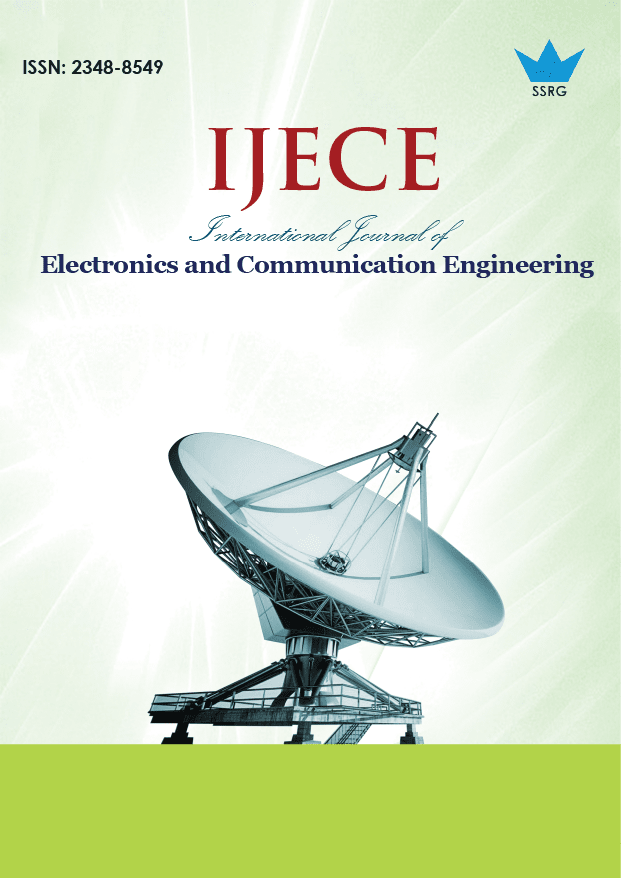A Hybrid Algorithm for Optimising AUV Path Planning and Precise Node Localization in UWSNs Using Cluster-Based Geometric Search Method

| International Journal of Electronics and Communication Engineering |
| © 2025 by SSRG - IJECE Journal |
| Volume 12 Issue 7 |
| Year of Publication : 2025 |
| Authors : R. Chiranth, K. Gopalakrishna |
How to Cite?
R. Chiranth, K. Gopalakrishna, "A Hybrid Algorithm for Optimising AUV Path Planning and Precise Node Localization in UWSNs Using Cluster-Based Geometric Search Method," SSRG International Journal of Electronics and Communication Engineering, vol. 12, no. 7, pp. 201-207, 2025. Crossref, https://doi.org/10.14445/23488549/IJECE-V12I7P115
Abstract:
Underwater Wireless Sensor Networks (UWSNs) play a vital role in aquatic monitoring and marine exploration, yet they face persistent challenges due to limited communication bandwidth, energy constraints, and the complex mobility of Autonomous Underwater Vehicles (AUVs). This paper presents a novel hybrid optimization framework that combines an Energy-Aware K-Means clustering algorithm with a terrain-sensitive A* path planning method. The clustering mechanism groups sensor nodes based on both spatial coordinates and remaining energy levels, ensuring balanced data aggregation. Simultaneously, the enhanced A* algorithm navigates the AUV through energy-efficient paths, accounting for underwater terrain variations and current-induced drift. This integrated strategy enhances localization accuracy, reduces unnecessary AUV movement, and significantly extends network lifetime. Simulation results confirm that the proposed approach achieves substantial gains in energy efficiency, reducing energy consumption by over 80%, shortening traversal distance by 87.5%, and improving overall network sustainability by 91.4%. These outcomes demonstrate the effectiveness of the hybrid model in optimizing data collection and node coordination in dynamic, large-scale UWSNs.
Keywords:
AUV path planning, Node localization, Geometric search model, A* algorithm, Energy-aware clustering.
References:
[1] Mohammad Alsulami, Rafaat Elfouly, and Reda Ammar, “Underwater Wireless Sensor Networks: A Review,” Proceedings of the 11th International Conference on Sensor Networks SENSORNETS, vol. 1, pp. 202-214, 2022.
[CrossRef] [Google Scholar] [Publisher Link]
[2] Xiaohui Wei et al., “Reliable Data Collection Techniques in Underwater Wireless Sensor Networks: A Survey,” IEEE Communications Surveys & Tutorials, vol. 24, no. 1, pp. 404-431, 2021.
[CrossRef] [Google Scholar] [Publisher Link]
[3] Bingbing Zhang et al., “Autonomous Underwater Vehicle Navigation: A Review,” Ocean Engineering, vol. 273, 2023.
[CrossRef] [Google Scholar] [Publisher Link]
[4] Yue Yang, Yang Xiao, and Tieshan Li, “A Survey of Autonomous Underwater Vehicle Formation: Performance, Formation Control, and Communication Capability,” IEEE Communications Surveys & Tutorials, vol. 23, no. 2, pp. 815-841, 2021.
[CrossRef] [Google Scholar] [Publisher Link]
[5] Fahad Jalal, and Faizan Nasir, “Underwater Navigation, Localization and Path Planning for Autonomous Vehicles: A Review,” 2021 International Bhurban Conference on Applied Sciences and Technologies (IBCAST), Islamabad, Pakistan, pp. 817-828, 2021.
[CrossRef] [Google Scholar] [Publisher Link]
[6] Arif Wibisono et al., “A Survey on Unmanned Underwater Vehicles: Challenges, Enabling Technologies, and Future Research Directions,” Sensors, vol. 23, no. 17, pp. 1-29, 2023.
[CrossRef] [Google Scholar] [Publisher Link]
[7] Rafał Kot et al., “A-Star (A*) with Map Processing for the Global Path Planning of Autonomous Underwater and Surface Vehicles Operating in Large Areas,” Applied Sciences, vol. 14, no. 17, pp. 1-22, 2024.
[CrossRef] [Google Scholar] [Publisher Link]
[8] Gianni Cario et al., “Accurate Localization in Acoustic Underwater Localization Systems,” Sensors, vol. 21, no. 3, pp. 1-24, 2021.
[CrossRef] [Google Scholar] [Publisher Link]
[9] Junhai Luo et al., “Localization Algorithm for Underwater Sensor Network: A Review,” IEEE Internet of Things Journal, vol. 8, no. 17, pp. 13126-13144, 2021.
[CrossRef] [Google Scholar] [Publisher Link]
[10] Kaveripakam Sathish et al., “Review of Localization and Clustering in USV and AUV for Underwater Wireless Sensor Networks,” Telecom, vol. 4, no. 1, pp. 43-64, 2023.
[CrossRef] [Google Scholar] [Publisher Link]
[11] Xiaohong Li, and Shuanghe Yu, “Three-Dimensional Path Planning for AUVs in Ocean Currents Environment Based on an Improved Compression Factor Particle Swarm Optimization Algorithm,” Ocean Engineering, vol. 280, 2023.
[CrossRef] [Google Scholar] [Publisher Link]
[12] Shaokun Yan, “Research on Path Planning of AUV Based on Improved Ant Colony Algorithm,” 2021 4th International Conference on Artificial Intelligence and Big Data, Chengdu, China, pp. 121-124, 2021.
[CrossRef] [Google Scholar] [Publisher Link]
[13] Siqi Lin et al., “Improved Artificial Bee Colony Algorithm Based on Multi-Strategy Synthesis for UAV Path Planning,” IEEE Access, vol. 10, pp. 119269-119282, 2022.
[CrossRef] [Google Scholar] [Publisher Link]
[14] Bo Guo et al., “An Improved A-Star Algorithm for Complete Coverage Path Planning of Unmanned Ships,” International Journal of Pattern Recognition and Artificial Intelligence, vol. 36, no. 3, 2022.
[CrossRef] [Google Scholar] [Publisher Link]
[15] Kun Hao et al., “Dynamic Path Planning of a Three-Dimensional Underwater AUV Based on an Adaptive Genetic Algorithm,” Ocean Engineering, vol. 263, 2022.
[CrossRef] [Google Scholar] [Publisher Link]
[16] Monika Chaudhary et al., “Underwater Wireless Sensor Networks: Enabling Technologies for Node Deployment and Data Collection Challenges,” IEEE Internet of Things Journal, vol. 10, no. 4, pp. 3500-3524, 2022.
[CrossRef] [Google Scholar] [Publisher Link]
[17] Sathish Nanthakumar, and P. Jothilakshmi, “A Comparative Study of Range Based and Range Free Algorithms for Node Localization in Underwater,” e-Prime - Advances in Electrical Engineering, Electronics and Energy, vol. 9, pp. 1-8, 2024.
[CrossRef] [Google Scholar] [Publisher Link]
[18] Mamta Nain et al., “A Survey on Node Localization Technologies in UWSNs: Potential Solutions, Recent Advancements, and Future Directions,” International Journal of Communication Systems, vol. 37, no. 16, 2024.
[CrossRef] [Google Scholar] [Publisher Link]
[19] Francesco Maurelli et al., “AUV Localisation: A Review of Passive and Active Techniques,” International Journal of Intelligent Robotics and Applications, vol. 6, pp. 246-269, 2022.
[CrossRef] [Google Scholar] [Publisher Link]
[20] Luyao Li, Yang Qiu, and Jing Xu, “A K-Means Clustered Routing Algorithm with Location and Energy Awareness for Underwater Wireless Sensor Networks,” Photonics, vol. 9, no. 5, pp. 1-14, 2022.
[CrossRef] [Google Scholar] [Publisher Link]

 10.14445/23488549/IJECE-V12I7P115
10.14445/23488549/IJECE-V12I7P115